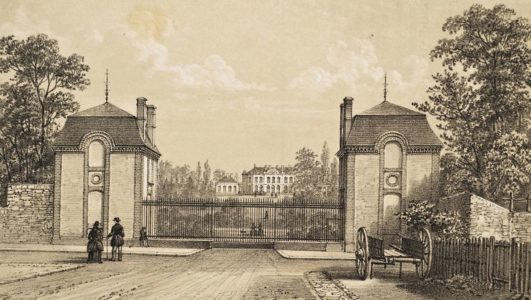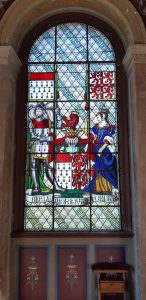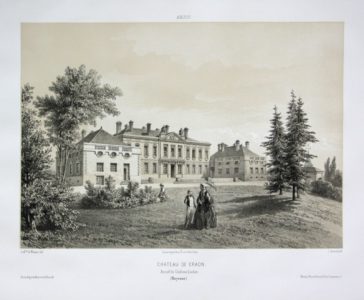Nickname "le petit Versailles de la Mayenne", the château de Craon was build on Guinefol hill in white stone of the Loire by the Marquis Pierre-Ambroise de la forest d'Armaillé in 1776, just before the french revolution.
The château is surrounded by a park in the "english style" and immediately arround the château by a french park which perfectly complements this beautiful house.
The owners of château de Craon, from past today

- Pierre-Ambroise de la Forest d'Armaillé (1734-1806) baron de Craon, comte de Gonnor et du puy du fou, inherit the baronnie of Craon, he build the Château, he has a daughter:
- Marie-Camille comtesse de Cossé-Brissac (1759-1827), at the time of her death, his son Artus de Cossé Brissac sold le château for helping his sister Délie de Cossé Brissac in the construction of monastry "bénédictine de Craon" She was the mère prioress.
- Guillaume de Champagné (1766-1831) buy the château in 1828. He is married with Adélaïde de Bonneval. They had 2 children: Clémentine (1798-1857) and Edouard
- Édouard de Champagné (1802-1840) Married to Marie-Ernestine Loys de La Grange (1817-1887) Ernestine is early widdows and she was the director of the domaine during 40 years.
- René de Champagné (1838-1890) married to Amicie Loys de La Grange (1853-1886) she is buried in the chapel with her son Juhel who dead at five years old, 2 others boys wath dead young.
- Alain de Champagné (1874-1918) the last son of René inhérit of the château, he is married to Hélène de Langle (1873-1954) They had no children. After the death of his first husband, she married in second wedding with Fortuné d'Andigné(1867-1935) he was the man who create the french garden.
- Louis de Guébriant (1916-2005) was the nephew of Alain de Champagné, he succed to his aunt in 1954, il married to Anne Loys de La Grange (1918-1958) They had 8 children, Their son, François is dead the day of his birth and is buried inthe chapel. At the death of his wife, louis married in second wedding with Geneviève de la Chaise, she was the widdow of Royal Air Force officer.
- Loïk de Guébriant (1954- ) Son of Louis de Guébriant is married to Hélène Devaux (1956- ) They had 6 children. They lived in the château form 1984 to 2018.
- Bertrand de Guébriant(1980- ) eldest son of loïk de Guébriant is married to Séverine Lancelot (1979- ) They are living in the château Since March 2018 with their 5 children.
the baronnie of Craon
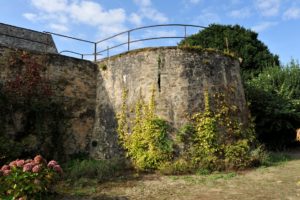
Craon is a town on the Oudon to the borders of Britain with a large area district called the Craonnais. It is the most important barony of Anjou and the owners of this land call themselves first barons. It was possessed in the eleventh century by a lord named Guérin on whom Geoffroy Martel Earl of Anjou, having confiscated it in 1050 gave it to Robert de Nevers, nephew of his wife. Renaud said the Burgundian had it then and his posterity took the nickname of Craon and kept this land until the death of Amaury IV lord of Craon. His sister Isabeau de Craon carried the barony of Craon into the house of La Trémoille. Charlotte-Catherine daughter of Louis de la Trémoille third of the name married in 1586 Louis de Bourbon prince de Condé to whom she bore the dowry a barony of Craon which then passed in 1720 in the house of Aloigny-Rochefort and which was sold to the d'Armaillé who had the current castle built between 1773 and 1776. The Marquis d'Armaillé when he inherits the castle of Craon, an old feodal house destroyed in part by the wars of religion and by Henri IV who wiped out part of it, decides to build a hunting relay, a veritable palace in the countryside worthy of its power and fortune. It is the architect Pomeyrol who realized the plans of the castle that we know today. Today we can still admire the traces of the feodal past of the castle of Craon in the vegetable garden.
Architecture

The eighteenth-century building consists of a large rectangular one-storey building with two pavilions forming short wings. It is constructed of cut stone, of the tuffeau of the Saumur region, with the exception of the lateral walls of the fitted brick pavilions. The two facades oriented north-The east and southwest are pierced by slender windows with carved lintels and sills, topped by attics – a secondary floor that completes the upper part of the building – decorated with vases and statues. A pediment adorns the centre of each façade
The construction of the castle is based on the four elements represented by four sculptures arranged at the four corners of the house: water and fire (northeast façade), earth and air (southwest façade). The northeast façade opens onto the main courtyard. The decoration draws the attention of the visitor to the centre of the residence, on the entrance surmounted by a pediment bearing the arms of the Champagné and Langle families. At the ends of the housing body, two semi-circular constructions ensure the connection with the pavilions and break the stiffness of the architectural lines.
The southwest façade overlooks the garden, with curves and rounded corners in quarter circles. Three bays form a slight forebody of the house pierced by three large semicircular openings and surmounted by a pediment decorated with a mythological scene: Flore crowned with flowers by a small Amour carrying a mirror. This less austere facade appears more elegant and refined than the northeast facade with a decor of drapes, garlands and mascarons (sculpted female heads). Two pavilions frame the main residence. These lateral annexes are lower than the main body of the house and are placed at right angles on either side of the porch on the northeast façade while they appear in a recessed position on the southwest façade.

To the north-east of the castle, in the extension of the side pavilions and square the main courtyard are two quadrangular buildings flanked by four corner turrets. It is the chapel to the north and the carpentry pavilion to the east.
 The two brick pavilions have tuffeau opening frames, which are reminders of the main building. An illustration of the Neoclassical style of the eighteenth century, the Château de Craon borrows its inspiration from the Parisian workshops with its proportions, its pure forms and its Greek ornamentation. “The building shows the pace at which the province is integrating into the general movement of art, commissioned from Paris”.
The two brick pavilions have tuffeau opening frames, which are reminders of the main building. An illustration of the Neoclassical style of the eighteenth century, the Château de Craon borrows its inspiration from the Parisian workshops with its proportions, its pure forms and its Greek ornamentation. “The building shows the pace at which the province is integrating into the general movement of art, commissioned from Paris”.
The interiors
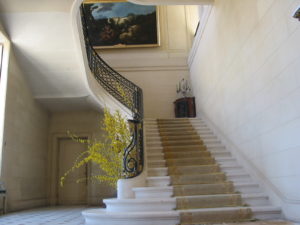
the interiors of the castle were modified in the 19th and 20th centuries. These renovations, carried out mainly in 1843 and then between 1897 and 1900, concerned in particular the dining room, the mezzanines of the pavilions and the entrance vestibule. They accompany the construction of a monumental staircase of honour. The space is thus redistributed around a vast entrance on which opens this marble staircase serving the first floor and having a natural lighting until then non-existent, which highlights a 17th century painting attributed to Rosa de Tivoli.
Marquis Alain de Champagné called on three renowned Parisian architects, MM. Coulomb, Chauvet and Visseaux, to carry out the modernization work of the castle at the end of the fourteenth century. Mr. Chauvet made a name for himself in the interior decoration of the Eiffel Tower for the 1889 World’s Fair. New standards of comfort are emerging at the Château de Craon with the installation of bathrooms, caloriferous (coal heating) and electricity. The castle of Craon was the first monument of Craon to benefit from the electricity that was manufactured by a large engine installed in the laundry of the castle. It is still visible today.
On the first floor, the distribution of the pieces through a long corridor (with portraits of all the kings of France) is always in order. Only an old bedroom was removed to open the staircase landing while another adjoining room was converted into lingerie. On the side of the servants' pavilion (northwest), the service staircase remains unchanged and serves the floor where a central corridor distributes the rooms among which an oval room. It is especially on the ground floor that the arrangement of the new staircase on the side of the hall of honour will upset the space and the interior life of the castle.
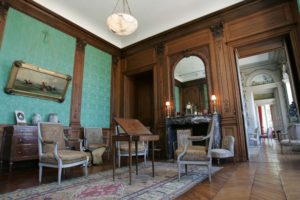 A smokehouse replaces the bedroom apartment on the ground floor. Another bedroom is transformed into an intermediate living room between the large living room and the small living room located next to the smoking room. Like the grand staircase, the dining room was renovated in the fashionable Louis XVI style at the end of the 19th century, which is perfectly in line with the castle’s construction date.
A smokehouse replaces the bedroom apartment on the ground floor. Another bedroom is transformed into an intermediate living room between the large living room and the small living room located next to the smoking room. Like the grand staircase, the dining room was renovated in the fashionable Louis XVI style at the end of the 19th century, which is perfectly in line with the castle’s construction date.
 Columns on each wall, between the openings, are removed and replaced by painted wooden pilasters imitating marble and topped with Ionic capitals. Above the doors, panels are decorated with scenes mixing small Amours. Next to the dining room, the large living room has not undergone any renovation and consecrates the taste Louis XVI. The walls are decorated in the same way: consoles with floral decoration and panels depicting Italian landscapes, including a view of the Bay of Naples. Carved cornices surmount doors that open onto adjoining rooms.This 18th century decoration uses symmetrical layouts inspired by Greece to give the interior of the castle the appearance of ancient rooms.
Columns on each wall, between the openings, are removed and replaced by painted wooden pilasters imitating marble and topped with Ionic capitals. Above the doors, panels are decorated with scenes mixing small Amours. Next to the dining room, the large living room has not undergone any renovation and consecrates the taste Louis XVI. The walls are decorated in the same way: consoles with floral decoration and panels depicting Italian landscapes, including a view of the Bay of Naples. Carved cornices surmount doors that open onto adjoining rooms.This 18th century decoration uses symmetrical layouts inspired by Greece to give the interior of the castle the appearance of ancient rooms.
Designed in a row, the rooms on the ground floor opening southwest onto the garden have retained their original arrangements and decorations, including remarkable carved panelling. Thus the small living room is decorated with carved panels of wreaths of flowers and mascarons. Garlands frame mirrors and portraits painted in ovals. In the music room, the decorations reproduce a Louis XIV style: with spears and quiver framing the mirror and alcove sow floral motifs and musical instruments. The alcove in the wall indicates that this living room is a former “bedroom apartment”.
In the 1920s, the owners continued the renovation of the castle in the style of Louis XVI. The library, the vestibule and the dining room are thus decorated and furnished to give the interior of the castle a unit of style that corresponds to its architecture.
Inspired by Versailles
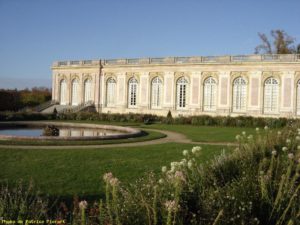
The 18th century is traditionally called the Enlightenment Century. This is an ideological term emphasizing the dynamism of this century, which parallels the 2 centuries preceding the Renaissance. The main innovation of the Age of Enlightenment is the rejection of ideas by Cartesianism. We reflect and seek in the discussion to mark his ideas and his conceptions. One studies nature and its relations with man; the encyclopedia of d'Alembert and Diderot sums up this well. The growing power of the bourgeoisie to the detriment of the nobility, especially the greatest! It is thus a century of reasoning and criticism; one philosophers in circles and salons where the great minds of the time are invited. The writer and the philosopher can finally make a living from their pen because they are recognized and esteemed. The sciences develop in consequence. Man is optimistic and has faith in himself, in his future and in nature. This attitude of self-confidence and self-awareness contains the ferments of the Revolution. It is also a fruitful period for international relations that facilitate the exchange of ideas, works, ... It is the strong economic development of all nations, the increasing demography, the political stability and the decline of absolute powers that are at the root of this evolution of mentalities. We then see the appearance of an art intended to satisfy a real need to embellish its living environment and for a greater number of individuals of different social levels!

Thanks to its language and its way of life, France dominates this century until about 1760 (fascination exercised by Versailles, Vaux le Vicomte...), also thanks to the balance between the various artistic tendencies. Two major currents in this century: rockery and neo-classicism. The Rococo style from the "rocaille" stream was born in France around the middle of the 18th century. It was a reaction of the nobility against the classical baroque imposed by the court of Louis XIV. It is an aristocratic style that reveals a taste for the light, the elegant, the refined and the gallant. It harmonizes with a casual, pleasant and loving life of nature. The characteristics of this style hang on to its name.The south façade of Craon’s castle is inspired by it.

The 18th century is divided into 3 major periods:The first 30 years when late Baroque predominates The central years that see the appearance and spread of the rock-rock or rock-rock style The last 30 years of neo-classicism that correspond to the style of the Craon castle in particular the facade north

